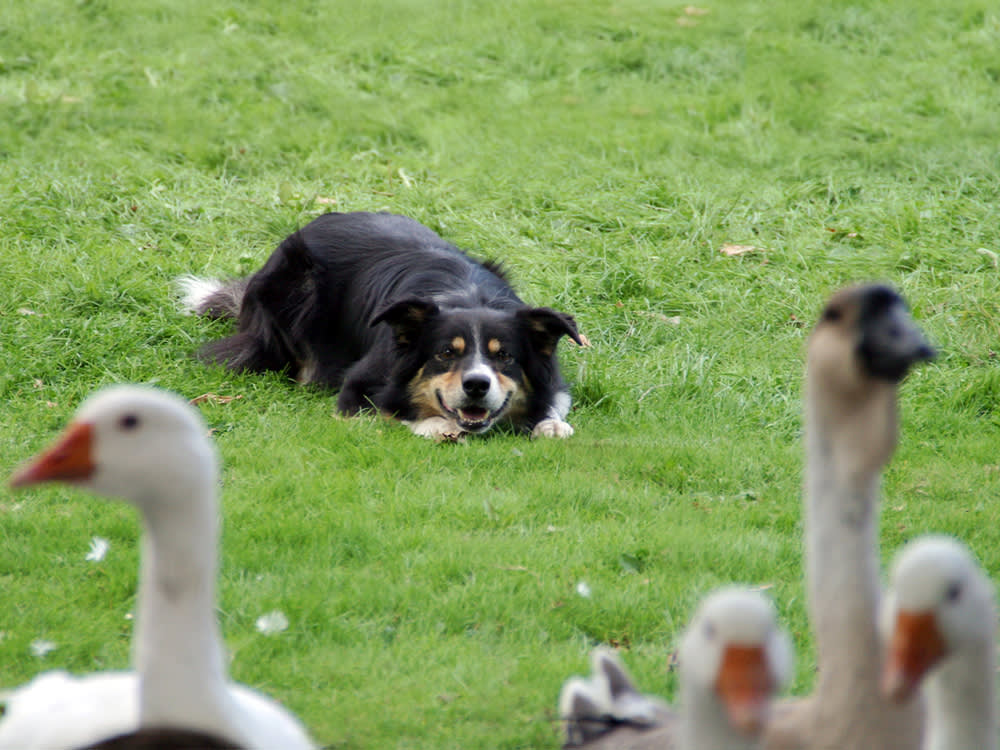What to Know About Bird Flu in Cats and Dogs
Several cats and one dog in North America have died of the virus. Here’s how to keep them safe.

Share Article
A new strain of the H5N1 virus — more commonly known as “avian flu” or “bird flu” — has been spreading rapidly among birds since 2020; according to the CDCopens in new tab, over 70 million birds have been infected. But in the past few months, a new development has worried infectious disease scientists and pet parents alike: Mammals, including domestic pets, have been diagnosed with H5N1 — and several of these cases have been deadly.
At least six cats have been diagnosed with H5N1 this year; most recently, two cats in Nebraska and one in Wyoming died of the virus. The Wyoming State Veterinary Laboratory released a statementopens in new tab clarifying that the cat most likely contracted bird flu by “ingesting meat from wild waterfowl.” In January, two Oregon cats who lived in close contact with chickens died after becoming lethargic, depressed, and dehydrated.
And cats aren’t the only pets suffering from the contagious disease. Last week, a dog in Ontario, Canada died of bird flu, making him the first domestic dog to be diagnosed with the new strain. The good news is, according to the American Veterinary Medical Associationopens in new tab, “the likelihood of cats and dogs catching HPAI seems very low.” Still, given its potential deadly consequences, it’s important to know how to keep your pet safe and what to look out for if you suspect they’ve been exposed to bird flu.
How to keep your pet safe from bird flu
If you’ve ever received the icky “gift” of an animal’s corpse on the doorstep from your cat, you know how much they like chasing birds and rodents — and how talented they are at catching them. “It is a good practice to keep cats indoors for many reasons, and this is one more good reason to do so,” veterinarian Dr. Amy Fox says. “Cats that go outside are more likely to hunt, kill, and/or eat birds.”

Puppy outdoor time should be closely monitored, too. “Avoid walking dogs near areas with high concentrations of wild birds or bird droppings which may be concentrated around bird feeders,” Dr. Fox says. Never let your dog catch or play with birds (living or dead). And if your dog shares a lot of space with poultry, you should separate them as much as possible.
You should also be careful about what you’re feeding your pet. In a case report from Dr. Sarah Sillman of the University of Nebraska, Dr. Sillman writesopens in new tab, “Keeping cats indoors to prevent wild bird contact — particularly given the context of the current HPAI outbreak – and avoiding feeding uncooked poultry are recommendations to minimize risk of H5N1 infection.”
What are the symptoms of bird flu in dogs and cats?
Again, it’s highly unlikely that your pet will be infected with the bird flu, so don’t panic. Dogs and cats become infected with bird flu by eating infected birds or spending sustained time in close contact with infected birds.
“Some signs could include fever, lethargy, difficulty breathing, coughing, runny nose, and/or signs of conjunctivitis which includes red eyes, eyes that appear squinty or sealed shut, and/or eyes with goopy greenish yellow discharge,” Dr. Fox says. They can also show extreme confusion, changes in behavior, weight loss, dehydration, lethargy, and loss of awareness of their surroundings. The cat in Nebraska had symptoms of confusion, including walking in circles, and eventually developed severe tremors.
Because of the low infection rates, there isn’t yet much research on how bird flu presents in dogs and cats. If your pets present symptoms of illness, including behavioral changes, after potential exposure to a bird infected with bird flu, it’s recommended to get them to the veterinarian as soon as possible.
Can pets transmit bird flu to humans?
As of yet, there has never been a case of a human acquiring bird flu from a mammal of a different species; according to the Canada Food Inspection Agencyopens in new tab, it’s theoretically possible, but extremely unlikely. In fact, there hasn’t been a single case of person-to-person transmission of the new strain of bird flu, either. “Animals other than birds are considered ‘dead-end hosts,’ meaning that while they may show symptoms of the virus, the virus cannot infect them as efficiently as it does in birds, and therefore these other species are less likely to be able to spread the virus to others,” Dr. Amy Fox says. The CDC states that humans most often contact bird flu through “exposure to the saliva, mucous, or feces from infected birds.”
According to the World Health Organizationopens in new tab, the threat of bird flu to humans remains low. In the United States in 2022, there has only been one case of bird flu in a humanopens in new tab: a man who worked closely with poultry and has made a full recovery. There was a recent case of a human infected with bird flu in Chileopens in new tab, and a tragically fatal case in Cambodiaopens in new tab in February.
Despite its low risk to humans, there has been an increase in the number of mammals acquiring bird flu, which is raising alarm bells for some researchers — including Tedros Adhanom Ghebreyesus, the director of the World Health Organization, who recently statedopens in new tab that “the recent spillover to mammals needs to be monitored closely.” If you work closely with birds, it’s important to be aware of the symptoms of bird flu, keep good hygiene before and after handling birds, wear protective gear, such as gloves and goggles, and contact a health professional if there is any chance you’ve become infected. The CDC states that symptoms of bird flu in humans include a fever, cough, sore throat, shortness of breath, pink eye, headaches, muscle aches, diarrhea, headache, and a runny nose.

Sio Hornbuckle
Sio Hornbuckle is the Assistant Editor at Kinship, where they frequently write for the site. As a writer, they specialize in pet news, animal science, and pop culture. They live in New York City with their cat, Toni Collette.
Related articles
![grey and white cat with tongue sticking out]()
Why Does My Cat Keep Throwing Up?
Here’s when you should worry.
Does Your Dog Need a Flu Shot?
“Sick as a dog” isn’t just a phrase.
![black and white dog looking ill laying on couch]()
Warning Signs Your Dog Needs to Go to the ER — Stat
Trust me, I’m a vet.
![man and lab puppy on park road]()
When, Exactly, Should You Vaccinate Your Puppy?
If it’s time for a round of shots (no, not that kind), follow this guide.
![dog sneezing outside in grass]()
Why Do Dogs Sneeze?
Other than to completely freak you out.






